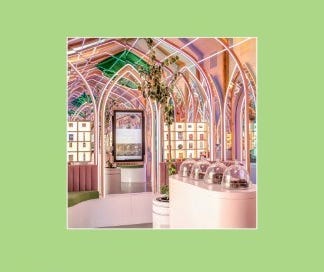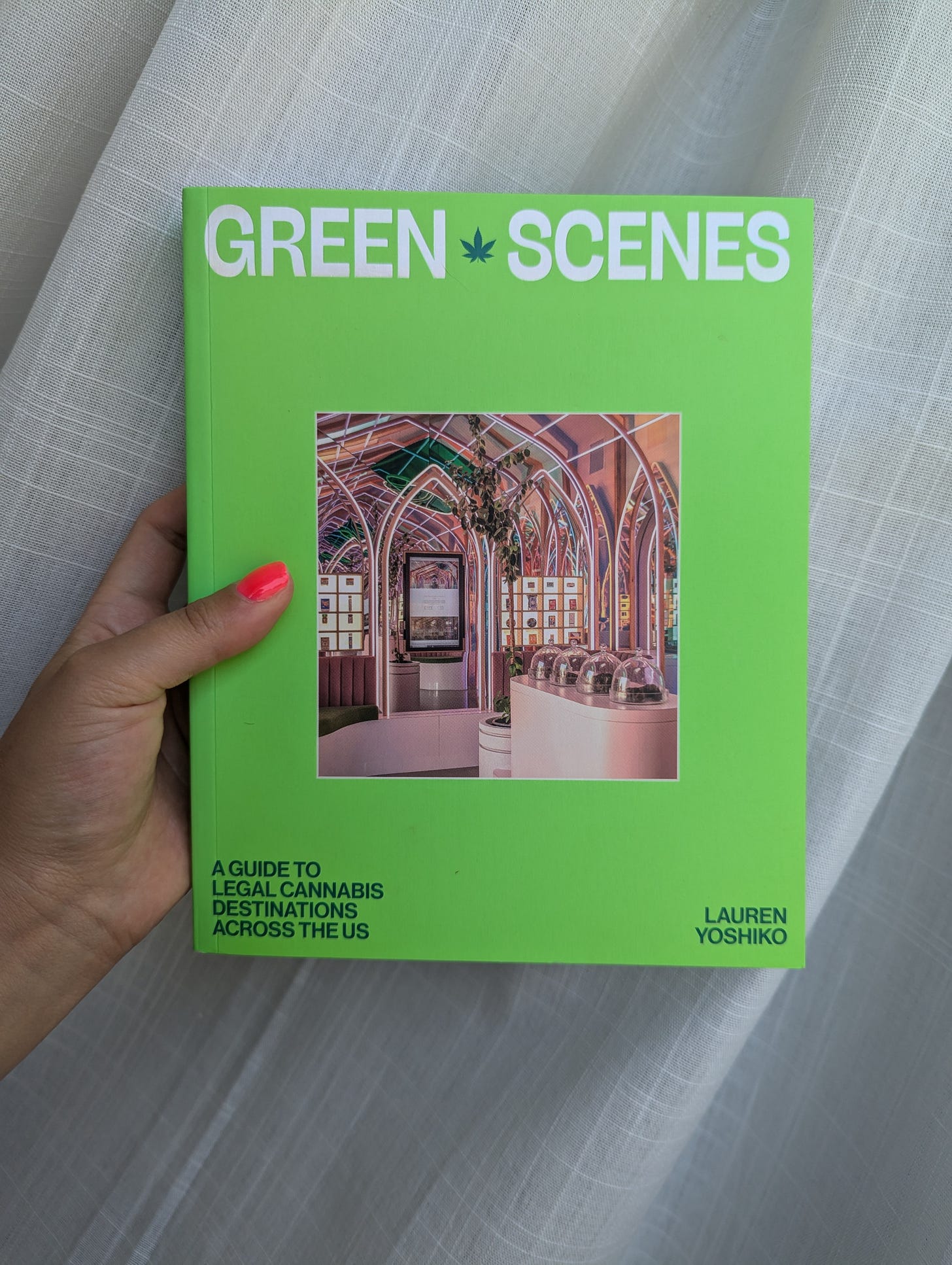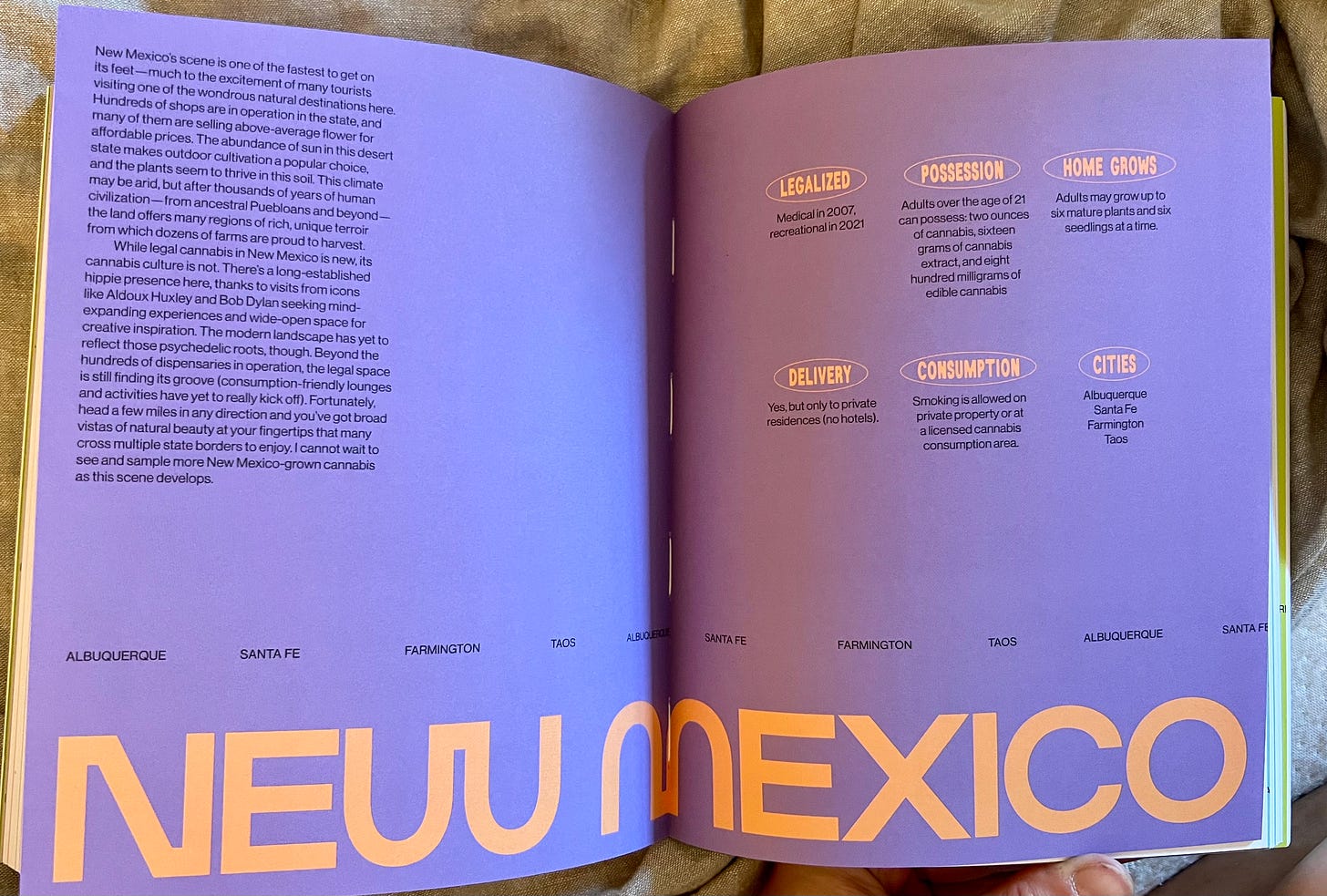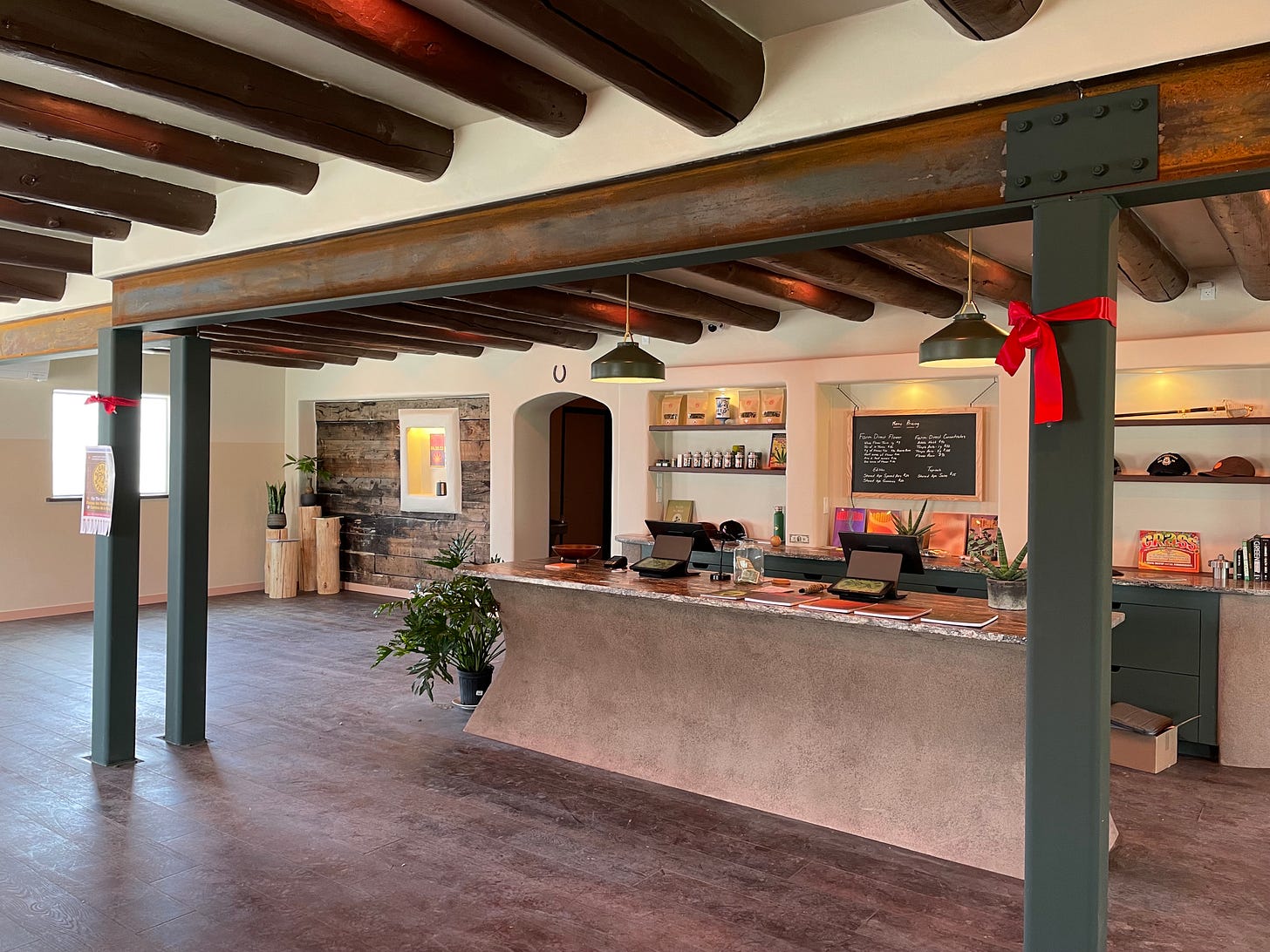Saturday Morning Sesh: A look at a very pretty cannabis book
A chat with Portland's Lauren Yoshiko, author of Green Scenes
Earlier this year, author, writer, and journalist Lauren Yoshiko (
and much more) published her first book, Green Scenes: A Guide to Legal Cannabis Destinations Across the U.S.In addition to being stunningly beautiful, befitting Yoshiko’s bonafides as a one-time Broccoli staffer and all-around aesthetics enthusiast, the book is a snapshot of a specific half-legal moment in the United States cannabis history. Hopefully, things will have changed years from now, so it’s cool to have thoughtful documentation of our culture along the way–she details 15 states and 33 cities and their cannabis cultures. Here, Yoshiko answers a few questions about her labor of love.
You can buy Green Scenes here. It makes a lovely coffee table book and is a great conversation starter.
1. Okay, let's do this. Why is that photo of that specific dispensary on the cover? To me, it exemplifies so much in modern, legalizing cannabis culture. There are layers; there's a lot behind it. Can you dig in?
I felt the same way. It was super important to me to offer a glimpse into the new world of weed and how far things have come from heady headshops of yore. This book is about capturing legal weed *right now*, so I wanted it to feel super fresh, modern, and almost jarringly unexpected. I wanted it to stop someone walking past it in a bookstore in their tracks, making them go, "Wait, THAT's what weed shops look like now? Holy shit."
This picture did that to me when I first saw it. After all my research across the country, there were a lot of cool shops, but none so visually arresting as LA's Wyllow. We considered a few different shots from the shop for the cover, but I never considered any other cover concept.
2. Why a travel book at this point in cannabis history?
It's not necessarily a travel guide, but it also is. The publisher's goal—Hardie Grant—was some kind of guide to what was happening across the US, this emergence of unique state markets from coast to coast. To me, the most logical way to accomplish that was to focus on the most developed states, offer a snapshot of the vibes of their weed scene, and highlight the shops, people, and experiences key to those communities.
One thing I really appreciated was their desire for me to take a really curated approach, skewing away from popular spots and towards those operated by people and philosophies that contributed to a more ethical and diverse industry. (Sometimes, those were also very popular spots).
I also just love practical guides that are useful in real life. The first writing project I led that was bigger than a single article was a comprehensive guide to Portland, OR, organized by neighborhood and designed with locals and tourists in mind. I get really inspired about creating physical tomes that help connect people to small businesses doing things with care in a way that has nothing to do with SEO or Google advertising.
3. What was the most surprising thing you learned about cannabis culture after writing this book?
I found the spectrum of cannabis culture is more or less pretty similar across the country. In my experience, the people who want to work in cannabis (who aren't just here to turn a profit) often share a lot of the same traits: people who believe in the disruptive potential of this plant medicine, creative people interested in the ways weed makes space for inspiration and whimsy, and people excited about the possibility of growing something of their own in a more thoughtful, sustainable way than the traditional extractive practices of Big Business.
The local culture of each region has an impact on how cannabis culture is expressed—i.e., more farm-focused scenes in agricultural hotspots like Vermont and Maine; and more experiential scenes in big cities—but I think what I really took away was how legal cannabis offers a really interesting entrepreneurial platform right now. Whether you're interested in agriculture, experimental gastronomy, alternative healthcare, or just the idea of building and running a community space with your family, cannabis is a lens through which many super unique and thoughtful businesses are launching right now.
4. How important was the art and design to this book, and why so? I know you have many thoughts about creativity and cannabis culture and the subtle ways both inspire each other. How is that borne out in your book and its art?
Super!!!! Design is so big, both in getting people's attention and helping rebrand outdated notions of weed as a dangerous illegal drug. Although utility played a role in the organization of the contents, the book itself was meant to be treated like a coffee table book first and foremost, helping destigmatize the cannabis space by being beautiful enough to display. We didn't have a budget for photography, so all the images were actually provided by the businesses and people featured—vibe really came down to the designer. The publishers knew I came from a background working with Broccoli, which set a bar of cannabis aesthetics for us to aim towards, so they were intentional about hiring a designer with playful and elevated taste. I think they nailed it and also did a great job capturing the broader picture I was trying to convey through choices like using different fonts and color schemes to express the different cultures of the West Coast, Southwest, Midwest, and East Coast.
A cherry on top that I particularly loved: each region also features a different color airbrushed in the gutter, so that when the book is closed, there is a rainbow ombre effect along the edges. A little reward for a closer, perhaps plant-altered look.
Here are two excerpts from Green Scenes: New Mexico and Maine
NEW MEXICO
New Mexico’s scene is one of the fastest to get on its feet—much to the excitement of many tourists visiting one of the wondrous natural destinations here. Hundreds of shops are in operation in the state, and many of them are selling affordable flower at above average quality. The abundance of sun in this desert state makes outdoor cultivation a popular choice, and the plants seem to thrive in this soil. This climate may be arid, but after thousands of years of human civilization—from ancestral Puebloans and beyond—the land offers many regions of rich, unique terroir from which dozens of farms are proud to harvest.
While legal cannabis in New Mexico is new, its cannabis culture is not. There’s a long-established hippie presence here, thanks to visits from icons like Aldous Huxley and Bob Dylan seeking mind-expanding experiences and wide-open space for creative inspiration. The modern landscape has yet to reflect those psychedelic roots, though. Beyond the hundreds of dispensaries in operation, the legal space is still finding its groove (consumption-friendly lounges and activities have yet to really kick off). Fortunately, head a few miles in any direction and you’ve got broad vistas of natural beauty at your fingertips that many cross multiple state borders to enjoy. I cannot wait to see and sample more New Mexico-grown cannabis as this scene develops.
BIGHORN WEED CO.
A family-run, veteran-owned dispensary vending craft flower out of a renovated blacksmith shop.
Ekin Balcıoglu and Steve Weiner arrived in the 6,600-person town of Taos without really looking into it. They just wanted to be somewhere other than Los Angeles during the darkest point of the COVID-19 pandemic. They fell in love with this place in a matter of days, though, and they never left. It could’ve been the mystical sunsets or the powerful history pulsing through the city in the form of the Taos Pueblo, a UNESCO Heritage Site and living Native American community that has been continuously inhabited for over one thousand years.
“People talk about the audible, sensory “hum” of the desert here. It’s real,” Weiner, who worked on a licensed cannabis farm in Humboldt before he’d ever heard of Taos, NM, said.
Once the state legalized cannabis, he saw an exciting opportunity to try things again in their new home, and perhaps help build a more successful environment for smaller, craft operators than California’s brutally competitive market. While the couple set about renovating a historic building that formerly housed a blacksmith shop, they started getting to know farms and launched a delivery-only store—the only delivery option north of Santa Fe, in an area that currently doesn’t even have pizza delivery.
“We believe you should know where your weed comes from and how it was grown,” Weiner explained. “We handpick small batches of cannabis from licensed farms that consciously grow in tune with our planet.”
Bighorn Weed Co.’s partners for grams and joint packs include Rising Roots, Taos Mountain Budz, and Gold Fish Farms—two of the three being New Mexican women-owned and operated. Inside the store, you’ll find stunning original wood features revealed by the historic renovation, curated art on the walls, and gardening books and indie magazines on the shelves that lend a living room energy to the space, beckoning folks to hang out for a while. The magazine selection includes Weiner and Balcıoglu’s Hamam Magazine, a publication dedicated to bathing art and culture—perfect reading material for a stay at the legendary Ojo Caliente Mineral Springs Resort & Spa a couple of towns over.
536 Paseo Del Pueblo Norte
Taos, NM 87571
CARVER FAMILY FARM
A cannabis dispensary, clone nursery, and plant and cacti boutique operated by old friends
As New Mexico’s largest city, I assumed my research would turn up a broad range of unique spots to shop and experience; however, one name continued to come up: Carver Family Farm. A couple sentences into my conversation with co-founder Mathew Muñoz—a fifteenth-generation New Mexican—and I understood why. It turns out that Muñoz’s family has a land grant from a Spanish King that dates back centuries! Mindblowing, right? The grower at Carver Family Farm is actually his old friend and co-founder, Andrew Brown, who he met while working at a headshop. Brown was the glass blower/resident flower dealer out back, and since they linked up, Muñoz hasn’t smoked anyone else’s flower. Erika Brown is the third co-founder and helps cultivate the high-quality, indoor-grown flower that Albuquerque residents seek out.
Their petite farmstand of a shop—a literal “microbusiness”—only stocks house flower, and the concentrates and vapes are all made with house-processed live resin bubble hash. The team has always intended to maintain quality, not quantity, so you might have to make two trips in order to catch an eighth of their signature Carver strain, bred by Andrew Brown in-house. That’s no inconvenience when there are numerous other plants to peruse in-house. CFF also grows award-winning cacti and succulents as well as hard-to-find peppers like Dragon’s Breath, Death Spiral, and heirloom Aleppo chilis—all of which you can buy as living plants inside the dispensary.
8917 Adams Street
Albuquerque, NM 87113
MAINE
Maine is the cannabis cultivation capital of the East Coast. Many New England operators I spoke to that had worked all over made the argument that Maine is home to the best concentrates and—depending on the strain—the best flower in the country. Even those living in neighboring states where cannabis is legal will make the drive across the border for some locally-grown goodness. There is a craft cultivation scene here that seems to stand a head above the rest, largely populated by small growers who care deeply about the way they grow the flower they provide to dispensaries. The twenty-five-year-old medical market has been largely populated by small boutique farms differentiated by unique strains and impeccable cultivation practices. There’s a long history of cannabis and hash competitions, unofficial 420 pot holiday gatherings, and a lack of dirty looks if you happen to smell extra fragrant when sitting down to enjoy some fresh-caught lobster.
Not-so-hidden gems abound in this intimate cannabis community and the equally intriguing food scene. In fact, Bon Appetit magazine named Portland the Restaurant City of the Year in 2018, and Biddeford was selected as one of America’s next great food cities in 2022 by Food & Wine. While many come for the seafood, it’s becoming a destination for vegetarians, vegans, and, of course, flower children like me who are interested in the other local greens.
HIGHER GROUNDS
You could consider Higher Grounds a well-stocked hemp dispensary that includes a cafe and, if you’re a certified patient in Maine’s medical program, a real weed menu. I consider it a brilliant, highly accessible way to help people understand the many reasons people turn to hemp and cannabis. When you walk in, it looks like any other chill, plant-filled third-wave café. That is until the barista asks if you have a medical card. If so, they’ll gesture you toward the dispensary part of the space, and, if not, you’ll stroll up to make your coffee order or shop their hemp-derived offerings. It’s a pleasant enough space that many come here just to open up their laptop and kick back for a few hours, as they would in any cafe. They have a hyper-local eye when stocking their shelves, prominently featuring full-spectrum CBD salves, tinctures, vapes, and certified organic, Maine-grown hemp flower from Rooted Heart Remedies and Mindful Earth. It’s not easy to find well-grown hemp pre-rolls online, but all the hemp and cannabis products here are
grown in this state. Higher Grounds is a founding member of the Maine Craft Cannabis Association—a group of independent cannabis businesses, advocates, and enthusiasts fighting for fair, local, and craft-oriented cannabis policy—and has a nurse practitioner on staff to offer guidance to any inquiring patients.
45 Wharf Street
Portland, ME 04101
MEOWY JANE
A cat-themed boutique and dispensary located in charming, walkable Old Port.
People told Noelle Albert that it wasn’t a good idea to name her medical marijuana dispensary after a cat pun, but she did it anyway, and she leaned all the way in. In this quirky shop, there are fake robo-kitties that move and purr, and there is more than one cat-themed ashtray on display. The Meowy Jane team also partners with shelters to host cat adoption events (at which most cats end up getting adopted). While some folks do come in assuming it’s some kind of cat cafe, most are intrigued to sit down and chat awhile, put at ease by the charming, airy space.
As a previously licensed medical shop, Meowy Jane was grandfathered into the adult-use system; however, due to Maine’s cannabis laws, their house flower hasn’t been able to hit the shelves just yet. A longtime cultivator, Albert is looking forward to it, but for now, she’s got plenty of trustworthy farms and producers she’s proud to recommend. She says edibles are the top seller for them, with many customers opting for the ease and fast-acting effects of infused drinks. The Hashery’s hash rosin-infused drinks can also be found here, as well as truly fresh-baked edibles from local brand Pot & Pan.
Even if you aren’t craving any cannabinoids, this is a great spot to stock up on solid smoking accessories, too. You can find pieces by GRAV, a reliable name that does simple, everyday glass pieces perfectly, as well as dainty, ornamental porcelain bongs by vintage refurbisher My Bud Vases. There’s also jewelry by local artists, indie magazines (yes, Broccoli’s in the house), CBD intimacy oil by East Coast favorite, Citrine, and a generally dream aesthetic that’s perfect for capturing any cat mom/stoner girl content.
3 Market Street
Portland, ME 04101
















Purchased! Thanks so much for writing about what seems like such a timely, gorgeous book in the cannabis space.